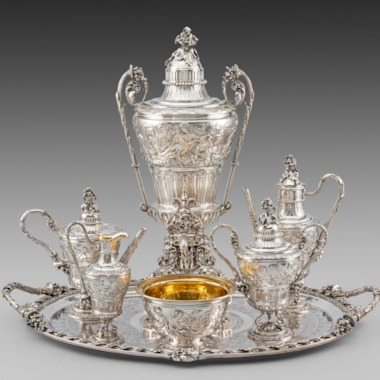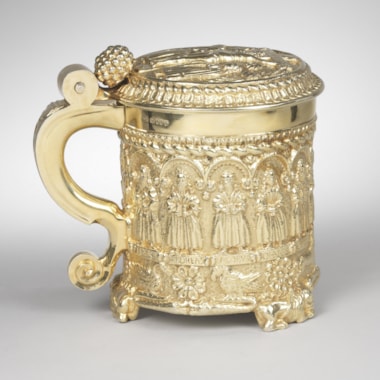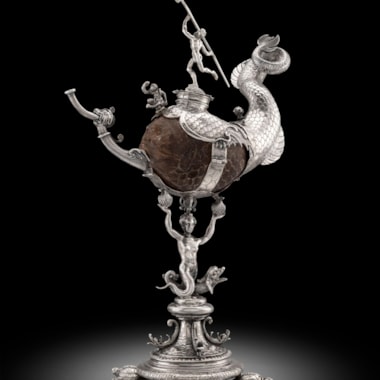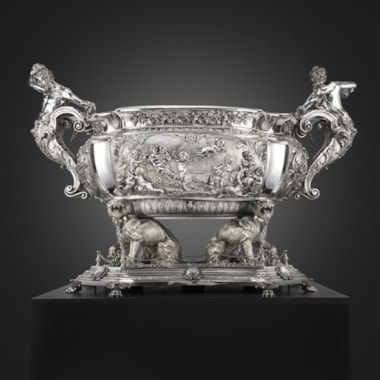Each on a triform base with a guilloche border and centering a rosette, supporting a tapering central column on three monopodiae, with alternating winged female masks and entwined serpents, the stem applied with acanthus leaves and bands of gadrooning, surmounted by three herm heads and supporting three dolphin and leaf-clad scrolling branches and a central light, with fluted waxpans and sockets, each stem engraved with a coat-of-arms, and THIRD DIVISION with military trophy surround, the waxpans and sockets engraved with a crest, both stamped RUNDELL BRIDGE ET RUNDELL AURIFICES REGIS ET PRINCIPIS WALLIAE REGENTIS BRITANNIAS
“A rough foul-mouthed devil as ever lived” was the Duke of Wellington’s assessment of his general, Sir Thomas Picton, Wales’s greatest soldier and the recipient of the candelabra. Trained as a soldier, Picton's career started slowly and indeed stalled following his tenure as the autocratic governor of Trinidad. His temperament was better suited to the battlefield, and it was during the Peninsular Campaign that Picton gained renown.
At the close of hostilities, as the Third Division disbanded, Picton’s officers presented him with a magnificent silver service costing £1600 raised by subscription. According to H. B. Robinson’s Memoirs of Lieutenant-General Sir Thomas Picton, 1835, such a generous gift was proof that Picton was not the harsh or neglectful commander that his critics had made him out to be. The soup tureen, entrée and meat dishes from this service, all by Paul Storr, sold in these rooms, 14 April 2005, lot 181.
A fearless and highly effective commander to the very end, Picton joined Wellington in June 1815, after Napoleon’s escape from Elba. Picton was injured at Quatre Bras, but carried on. Two days later, with his injuries far worse, “his body blackened but even swelled to a considerable degree” Picton fell in front of his division, shot through the head, never to know of the ensuing success at Waterloo.
In death, Picton’s controversial reputation was finally behind him and he received the honours due to him as one of England’s greatest generals. In 1827 a column surmounted by a statue of the General was erected at Carmarthen, while a sculptural group with Picton’s bust was installed in St. Paul’s Cathedral, where his remains were later interred, near those Wellington (Robert Harvard, Wellington’s Welsh General: A Life of Sir Thomas Picton, 1996)
Rundell’s made another pair of candelabra of this model for their Royal patron, the Duke of Cumberland (1771-1851), who, like his brothers the Prince of Wales and the Duke of York, was an important silver collector. The Cumberland pair, is illustrated in Christopher Hartop, Royal Goldsmiths: the Art of Rundell & Bridge, 1797-1843, fig. 48, p/60 (collection Dr. Gert-Rudolf Flick).
Sir Thomas Picton (1758-1815)
You May Also Like








































































